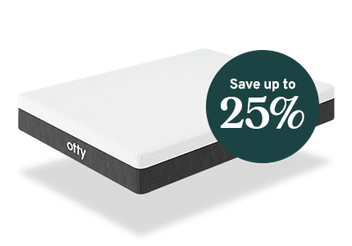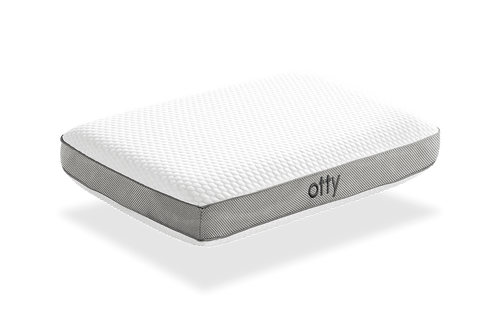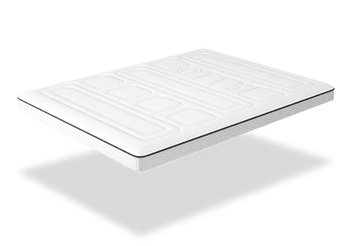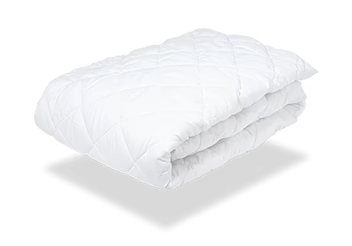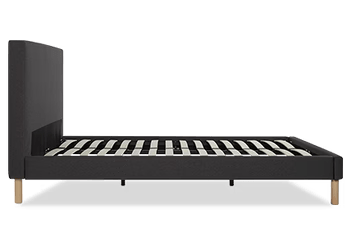Written By: Michal Szlas - Founder and CEO of Otty Sleep
Stumbling upon mould on your mattress can be quite a shocker, not to mention a health hazard.
This comprehensive guide will walk you through the process of identifying and removing mould from your mattress, as well as the dangers of mould growth, the causes, and the step-by-step guide on how to get rid of mould.
The Dangers of mould on a Mattress
mould on a mattress is more than just an aesthetic issue; it's a potential health hazard that needs immediate attention. The presence of mould can indicate a deeper problem within the mattress, often resulting from warm and humid conditions.
Understanding the dangers associated with mould on a mattress is crucial. It's not just about the unsightly stains or the unpleasant smell; it's about the potential health risks that come with exposure to different types of mould. From allergenic to toxic, each type of mould can trigger a variety of reactions, some of which can be severe.
Is Mattress mould Dangerous?
mould on a mattress is not just an unsightly problem; it can also pose significant health risks. The most common types of mould found on mattresses are allergenic, pathogenic, and toxic. Each of these moulds can trigger different reactions in individuals, depending on their sensitivity and overall health condition.
Allergenic moulds, while not life-threatening, can cause discomfort, especially for those with allergies. Symptoms can range from a stuffy nose and sore throat to coughing, wheezing, and skin rashes. Pathogenic moulds, on the other hand, can lead to infections, particularly in people with compromised immune systems or chronic lung diseases.
The most dangerous type is toxic mould. Exposure to this type of mould can lead to severe health issues, including respiratory problems and neurological damage. The Centers for Disease Control and Prevention (CDC) warns that prolonged exposure to mould can lead to serious health complications.
This can obviously be even more of a problem if you sleep on a double mattress with a partner and are both affected.
What Causes The Growth Of Mould On A Mattress?
Excess Moisture
One of the primary causes of mould growth on a mattress is excess moisture. This can occur due to spills, sweat, or even high humidity in the room.
Water Damage
If a mattress has been exposed to water damage, such as a flood or a leak, it can create an ideal environment for mould to thrive.
Humid Climate
Living in a warm, humid climate can also contribute to mould growth on a mattress. The combination of warmth and humidity provides the perfect conditions for mould spores to multiply.
Step-by-Step Guide on How to Remove mould from a Mattress
From vacuuming the mattress to using sunlight, rubbing alcohol, and even homemade cleaners, we'll cover a range of methods to help you eliminate visible mould from the surface of your mattress. Each method has its own set of advantages and is designed to suit different types of mould infestations.
How To Vacuum A Mattress To Remove mould
The first step in the process of removing mould from a mattress is to vacuum it thoroughly. This is a crucial step as it helps to get rid of any loose mould spores on the surface of the mattress. Start by grabbing a powerful handheld vacuum or a floor vacuum with a hose and an upholstery brush.
Begin at one end of the mattress and vacuum the entire surface, even the areas where there is no visible mould. It's important to remember that mould spores can be invisible to the naked eye, so it's best to cover all areas.
Don't forget to vacuum the sides of the mattress as well. Once you've finished vacuuming, take the vacuum outside to reduce the chances of spreading the mould spores. Empty the disposable bag or dust bin into a trash bag, seal it tightly, and dispose of it in an outdoor trash bin.
This process is not only effective in removing visible mould but also helps in reducing the number of mould spores that could potentially grow into a larger mould problem. Remember, the key to a successful mould removal process is thoroughness and attention to detail.
How To Remove mould From A Mattress With Sunlight
Sunlight is a natural mould killer and can be an effective tool in your battle against mould on your mattress. The ultraviolet (UV) rays from the sun are known to kill mould spores, making it an eco-friendly and cost-effective method to remove mould from a mattress.
To use this method, first, ensure that the mattress is dry. If it's not, use a dry towel to blot any wet areas. Once the mattress is dry, move it to a sunny spot. This could be a sunlit room in your house, or better yet, outside if the weather permits.
Leave the mattress in the sunlight for several hours. The UV rays will work to kill the visible mould on the mattress surface. Remember to flip the mattress halfway through to ensure all sides get exposed to the sunlight.
While sunlight can help remove mould from a mattress, it's not a guaranteed solution for severe mould infestations. If the mould persists, consider seeking professional help.
How To Clean A Mattress Of mould Using Rubbing Alcohol
To effectively remove mould from a mattress using rubbing alcohol, you need to follow a few simple steps. First, prepare a solution of equal parts isopropyl (rubbing) alcohol and water. This solution is potent enough to kill the mould spores on the mattress surface.
Next, dip a clean cloth into the solution and gently rub the mouldy surface of the mattress in a circular motion. Be careful not to saturate the mattress with an excessive amount of the cleaning solution. This is because it can damage the mattress, and it won't address any mould spores deep within the mattress anyway.
This method is effective for surface mould. If you suspect the mould has penetrated deeper into the mattress, it might be time to consider professional cleaning or even replacement.
Our guide to knowing when to replace your mattress can give you more pointers.
How To Remove mould From A Mattress Using Homemade Cleaners
When it comes to removing mould from a mattress, homemade cleaners can be a cost-effective and efficient solution. These cleaners are often made from common household items, making them easily accessible and safe to use.
One popular homemade cleaner is a mixture of vinegar and baking soda. Vinegar is known for its natural disinfecting properties, while baking soda is a great deodorizer. To use this cleaner, mix equal parts of vinegar and baking soda in a bowl. Apply the mixture to the mouldy areas of the mattress and let it sit for a few minutes. Afterward, scrub the area gently with a brush and wipe it clean with a damp cloth.
It's crucial to dry the mattress thoroughly after cleaning to prevent the growth of new mould spores. You can do this by placing the mattress in a well-ventilated area or using a fan to speed up the drying process.
How To Get Rid of mould From A Mattress Using Tea Tree Oil And Vodka
Tea tree oil, renowned for its antifungal properties, can be a potent weapon in your battle against mattress mould. When combined with vodka, it creates a powerful solution that can effectively kill mould and prevent its recurrence. Here's how you can use this potent mixture to get rid of mould on your mattress.
Start by mixing two teaspoons of tea tree oil with one cup of vodka. This ratio ensures a strong enough solution to kill the mould without damaging your mattress. Remember, tea tree oil is potent, so a little goes a long way.
Next, pour the solution into a spray bottle for easy application. Lightly mist the mouldy areas of your mattress, ensuring you don't oversaturate it. The alcohol in the vodka helps the tea tree oil penetrate the mould, killing it from the inside out.
Allow the solution to sit for a few hours to work its magic. Afterward, use a clean, damp cloth to wipe away the dead mould. Be sure to let your mattress dry thoroughly before replacing your bedding. This method is not only effective but also uses natural ingredients, making it a safer option for those with allergies or sensitivities.
Preventing Future mould Growth on Your Mattress
Preventing future mould growth on your mattress is a crucial step in maintaining a healthy sleep environment. This section will provide you with effective strategies to keep your mattress mould-free.
Improve Air Quality
Regularly ventilate your bedroom to maintain good air quality. This can be as simple as opening a window for a few hours each day. Fresh air circulation can help prevent the build-up of mould spores.
Use a Dehumidifier
If you live in a humid climate, consider using a dehumidifier in your bedroom. This device can help reduce the extra moisture in the air that mould thrives on.
Invest in a Mattress Protector
A good quality mattress protector or mattress topper can act as a barrier between the surface of your mattress and potential mould spores. It's an easy and effective way to prevent future mould growth.
Prevention is always better than cure. By following these tips, you can help ensure a mould-free sleep environment.
Check out our guide to mattress toppers for more tips, and learn how to clean your mattress topper to prevent mould from returning.
How Different Mattress Materials Affect mould Growth
The material of your mattress can play a significant role in the growth of mould. Different materials have varying levels of susceptibility to mould, and understanding this can help you make informed decisions about your bedding.
Memory foam mattresses, for instance, are known for their excellent comfort and support. However, they are also notorious for retaining heat and moisture, creating an ideal environment for mould growth. The dense structure of foam can trap humidity, making it difficult for the mattress to dry out completely, thus encouraging mould proliferation.
However, there are steps you can take to prevent a memory foam mattress from overheating.
On the other hand, natural latex mattresses are a different story. Pure latex, especially organic latex, is inherently resistant to mould and mildew. The natural properties of latex, combined with its open-cell structure, allow for better air circulation, reducing the chances of moisture build-up.
Final Thoughts on Removing and Preventing mould on Your Mattress
Dealing with mould on a mattress can be a daunting task, but with the right knowledge and tools, it's entirely manageable. Remember, the key to getting rid of mould is to act quickly, use effective cleaning solutions like rubbing alcohol, and ensure your mattress is thoroughly dried afterwards.
In the future, prevention is always better than cure. Maintain a clean, dry environment, use a dehumidifier if necessary, and regularly check your mattress for any signs of mould growth.
Remember, your health and comfort are paramount.
